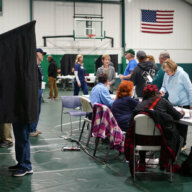By the time painter Steven Baris was in high school, he had lived on at least four different Native American reservations in the Pacific Northwest and California. The landscape must have felt foreign to his father, a lifelong New Yorker who happened to find a job with the Department of Indian Affairs. But Baris-the-younger couldn’t help but adopt some of the Native American reverence for land and place.
Since moving to Philadelphia in 1984 to attend the Tyler School of Art, Baris has been obsessed with the way that Americans relate to their environment.
His latest series of abstract paintings — “Stations of the Cube,” opening Friday at the Pentimenti Gallery — explores the hidden landscapes in which we live.
“Recently, I’ve been fascinated by distribution centers on the [N.J. Turnpike]. The landscape has been completely reinvented with these massive structures. Few people even go near these spaces other than truck drivers. We don’t think about them, but they have enormous impact on our lives,” says Baris. “Writers and artists and thinkers are always talking about cities, and the suburbs have been hashed over quite a lot over the last two decades. But there hasn’t been a whole lot of observation and reflection about these other spaces — these non-spaces.”
“Stations” is a series of 10 paintings — on canvas, Plexiglas and Mylar — ranging from 20 inches in diameter to nearly 7 feet and utilizing transparent paint — often on transparent surfaces, to boot.
“It’s a way to get at the kind of pictorial space that I’m trying to create: a hovering sense of not quite here, not quite there,” explains Baris. “For me, to work on a surface that is itself transparent really energizes the painting.”






























